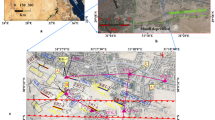Abstract
Complementary geophysical surveys on large landslides help revealgeologic structures and processes, and thus can help devise mitigation strategies. The combined interpretation of these methods enhance the result of each data set interpretation and makes it possible to derive a geological model of the landslide.
We chose a test site on the Boup landslide (Wallis, western SwissAlps) to test high-resolution seismic reflection surveyscombined with ground penetratingradar (GPR), electromagnetic (EM) and electrokinetic spontaneous potential (SP) measurements.
The results of the high-resolution seismic surveys suggest thatthe sliding is within a gypsum layer at 50 m depth and not as previously believed along a deeper (70 m) gypsum-shale boundary, also mapped seismically. Inversion of electromagnetic profiles (EM-34) with constraints from seismic data provided a model cross-section of conductivity values of the landslide (20–25 mS/m) and of the surrounding stable ground (10–15 mS/m), and it helped outline their boundary at depth.The accurate surface location of the landslide limit could be detected withelectromagnetic measurements of shallower depths of investigation (EM-31). Positive PS anomalies revealed an upward flow of mineralised water interpreted to follow the lateral boundary of the Boup landslide on its east side. Limited success was obtained withGPR profiling. This method can be hampered by conductive shallow layers, and itssuccessful application on landslides is expected to be strongly site dependant.
Similar content being viewed by others
References
Brooks, G.R. and Pilon, J.-A.: 1995, Ground Penetrating Radar Survey of the Katz Slide, Southwestern British Columbia, Current Research 1995-A, Geological Survey of Canada, pp. 33–40.
Cruden, D.-M. and Varnes, D.-J.: 1996, ‘Landslide type and processes’, in A.-K. Turner, and R.L. Schuster (eds.), Landslides: Investigation and Mitigation, Transportation Research Board Special Report 247, National Academy Press, Washington D.C.
Cummings, D. and Clark, B.-R.: 1988, ‘Use of seismic refraction and electrical resistivity surveys in landslide investigations’, Bulletin of the Association of Engineering Geologists XXV, 459–464.
Davis, J.-L. and Annan, A.-P.: 1989. ‘Ground-penetrating radar for high-resolution mapping of soil and rock stratigrapgy’, Geophys. Prosp. 37, 531–551.
Dikau, R., Brunsden, D., Schrott, L. and Ibsen, M.-L.: 1996: Landslide recognition. Identification, Movement and Causes, John Wiley & Sons, Chichester, 251 pp.
DUTI: 1985, Détection et Utilisation des terrains instables, Final Report, Ecole Polytechnique Fédérale de Lausanne, Lausanne, Juin 1985, 229 pp.
Gex, P.: 1990, Acquisition et interprétation des données de polarisation spontanée. Bibliographie générale sur les potentiels spontanés, Bullettin IGL, No. 8, Mai 1990, 50 pp.
Gex, P.: 1993, ‘Mesures délectrofiltration sur le glissement de terrain de la Frasse (préalpes romandes, Suisse)’, Hydrogéologie 3, 239–246.
Goryainov, N.-N., Matveev, V.-S. and Varlamov, N.-M.: 1988, ‘Use of geophysical methods for landslide and mudflow investigations’, in E.-A. Kozlowski (ed.), Landslides and Mudflows, Vol. 1, UNESCO, Moscow, pp. 134–145.
McCann, D.-M. and Forster, A.: 1990, ‘Reconnaissance geophysical methods in landslide investigations’, Engineering Geology 29, 59–78.
Pullan, S.-E. and MacAulay: 1987, ‘An in hole shotgun source for engineering seismic surveys’, Geophysics 50, 1684–1688.
Rötlisberger, G.: 1997, ‘Unwetterschaden in der Schweiz im jare 1996’, in Wasser, Energie, Luft 89, Jahrgang 1997, Baden, pp. 1–7.
Sartori, M.: in preparation. ‘Atlas géologique de la Suisse 1: 25,000’, Feuille 1306, Sion. Service Géologique et Hydrogéologique Nationale, Not. Explic.
Steeples, D.-W. and Miller, R.-D.: 1990, ‘Seismic reflection methods applied to engineering, environmental, and groundwater problems’, in S.H. Ward (ed.), Geotechnical and Environmental Geophysics. Investigation in Geophysic, No. 5, Society of Exploration Geophysicists, Tulsa, Oklahoma, pp. 1–31.
Vallario, A.:1992, Frane e Territorio. Le frane nella morfogenesi dei versanti e nell’uso del territorio, Liguori, Napoli, 548 pp.
Varnes, D.J.: 1978, ‘Slope movements: type and processes’, in: E.B. Eckel (ed.), Landslide Analysis and Control, Transp. Res. Board, Spec. Rep. 176, pp. 11–33.
Author information
Authors and Affiliations
Rights and permissions
About this article
Cite this article
Bruno, F., Martillier, F. Test Of High-Resolution Seismic Reflection And Other Geophysical Techniques On The Boup Landslide In The Swiss Alps. Surveys in Geophysics 21, 335–350 (2000). https://doi.org/10.1023/A:1006736824075
Issue Date:
DOI: https://doi.org/10.1023/A:1006736824075




